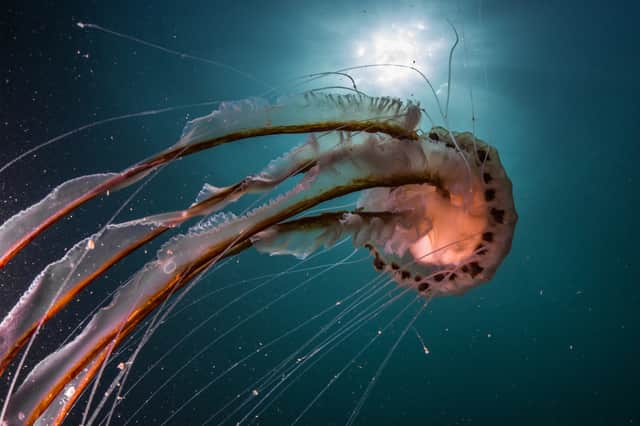Jellyfish are invading UK waters - here’s why and what to do if you get stung
This article contains affiliate links. We may earn a small commission on items purchased through this article, but that does not affect our editorial judgement.


With summer just around the corner, the British public are gearing up to hit the beach.
But those brave enough to venture into the sea will need to take extra care this year, as jellyfish invade our waters.
Advertisement
Hide AdAdvertisement
Hide AdHere’s why we’re seeing more jellyfish in our seas and what to do if you get caught out with a nasty sting.
Why will there be more jellyfish?
Not surprisingly, it’s all down to global warming, which is changing our ecosystems according to a study by the Intergovernmental Panel on Climate Change (IPCC).
With ocean temperatures rising, animals (and wobbly invertebrates) are able to move into areas that have previously been too cold for them.
And this, combined with oxygen levels in the sea falling by about two per cent over the last 50 years, creates the perfect environment for jellyfish to thrive.
Advertisement
Hide AdAdvertisement
Hide AdNational Geographic states: “One group of animals that are most likely to increase both in range and abundance due to warmer waters and changes in the acidity level of the ocean are jellyfish.”
But it’s not just climate change that’s to blame.
Overfishing means that numbers of tuna and swordfish, the natural predators of jellyfish, are on the decline.
With fewer predators posing a threat, jellyfish populations have been able to grow.
What kinds of jellyfish can you find in the UK?
The UK is home to six different types of jellyfish and two species of jellyfish-like animals.
Advertisement
Hide AdAdvertisement
Hide AdThe jellyfish-like animals are the Portuguese man o’war and the by-the-wind-sailor which are classified as siphonophores.
The six types of jellyfish found in British waters are:
Moon jellyfish (UK-wide)Compass jellyfish (mainly in the south)Blue jellyfish (common in South West and Wales)Lion’s mane jellyfish (North Wales, North Scotland)Barrel jellyfish (South West, Ireland, Wales, West Scotland)Mauve stinger (rare but can be found along the south coast)
The Portuguese man o’war can be found washed up along the South Coast if it gets blown in from the Atlantic Ocean.
The by-the-sea-sailor can be found along the South West and Welsh coastline if it’s blown in from the Atlantic Ocean.
Advertisement
Hide AdAdvertisement
Hide AdAre jellyfish dangerous?
UK jellyfish are not considered to be dangerous, however some species can have a nasty sting.
Their stings can range from mild, like the moon jellyfish, to very powerful, like the Portuguese man o’war which has the worst sting of all jellyfish and jellyfish-like animals.
What do I do if I’m stung?
While the TV show Friends might have you believe that urinating on the sting will relieve the pain, all that it’s likely to do is irritate the wound further.
The NHS advises that you should:
Rinse the area that was stung with seawater. Don’t use freshwater, as this will make the sting worse.If you can see the stinging spines from the jellyfish on your skin, carefully scrape them off. You could use the edge of a bank card or tweezers.Heat will help the sting, so you can soak the area in very warm water (as hot as can be tolerated) or you can use hot flannels or towels.Over the counter painkillers like paracetamol or ibuprofen will help ease the pain as well.
Advertisement
Hide AdAdvertisement
Hide AdIf the pain isn’t going away and it’s severe, you should go to the minor injuries unit.
Go to A&E, or call 999, if you experience:
Difficulty breathingPain in your chestFits or seizuresSevere swelling around the area that was stungSevere bleedingVomitingLightheadedness, dizziness or fainting.
This article originally appeared on our sister site Edinburgh Evening News